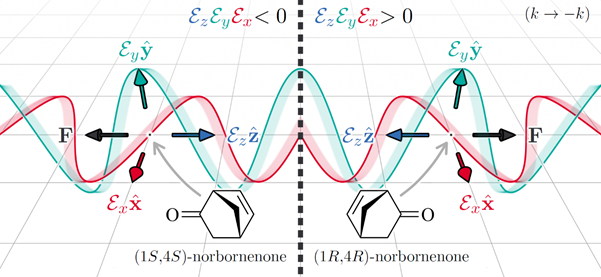Strong chiral optical force for small chiral molecules based on electric-dipole interactions, inspired by the asymmetrical hydrozoan Velella velella
Drawing inspiration from a remarkable chiral force found in nature, we propose an optical force that discriminates between the enantiomers of a small chiral molecule. Our chiral optical force is several orders of magnitude stronger than other chiral optical forces proposed to date and has a wealth of potential applications, including chiral molecular matter-wave interferometry for precision metrology and tests of fundamental physics, the distillation of chiral molecules in chiral optical lattices as a novel form of matter and, of particular importance, the resolution of enantiomers for use in chemistry and biology.
The idea behind our novel chiral force comes from the asymmetrical hydrozoan Velella velella, more commonly known as the “by the wind sailor”, which lives on the surface of the ocean and has a sail that tilts either anti-diagonally or diagonally with respect to a quasi-rectangular base, giving two distinct mirror-image forms.

Specimens found on the Japanese side of the Pacific are predominantly of the anti-diagonal form whereas those found on the North American side are predominantly of the diagonal form. It is believed that both forms arise in roughly equal numbers in the centre of the Pacific and are then separated by the wind. The origin of this chiral force can be understood as follows: a Vellela velella specimen is orientated by gravity via the normal force. With its sail blown by the wind, the specimen deflects air molecules from the initial air channel into a final air channel with an orthogonal component. The corresponding momentum transfer gives rise to a force with a chiral component. The normal force, initial air channel, and relevant component of the final air channel form either a left-handed or a right-handed orthogonal triad embodying the chiral sensitivity of the force.

In a recent publication, Robert P Cameron et al 2023 New J. Phys. 25 083006, we show that we can construct an analogous chiral optical force using a static electric field combined with an optical lin⊥lin polarization standing wave. In this case the Velella velella is replaced by a small chiral molecule and a static electric field plays the role of gravity, orienting the molecule via its permanent electric-dipole moment. Instead of the wind, we consider an intense and far off-resonance optical lin⊥lin polarization standing wave. The molecule transfers photons between polarization components of the standing wave with the resultant momentum transfer giving rise to the chiral optical force. The static electric field and the optical polarization vectors form either a left-handed or a right-handed orthogonal triad embodying the chiral sensitivity of our force, as illustrated.

Our chiral optical force is several orders of magnitude stronger than other chiral optical forces proposed to date, being based on leading electric-dipole interactions rather than relying on weak magnetic-dipole and electric-quadrupole interactions, and applies to most small chiral molecules. We believe that it will render potential applications enormously more robust and easier to implement than previously thought possible.
August 2023